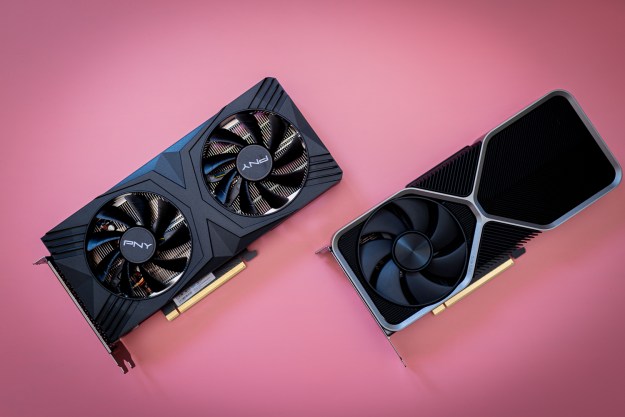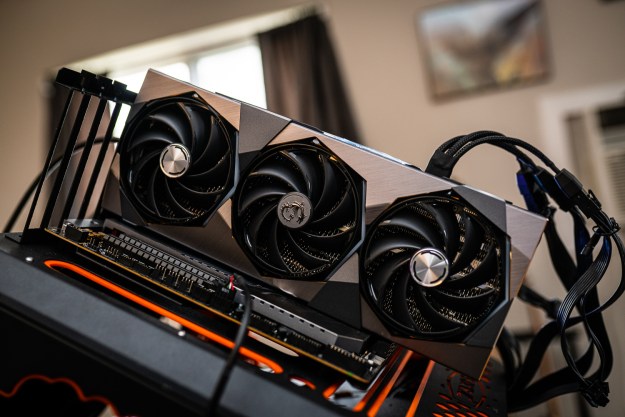Part of the fun of the NVIDIA GPU Technology conference is that you see stuff that you don’t see any place else. Some of this stuff is actually on the market, but much of it is waiting for a hardware manufacturer to pick it up, or can only be purchased by large companies or governments. An example of the latter is the Photonic Fence which would be so cool to own but likely outside of anyone but Bill Gate’s budget (his foundation is partially funding this effort). So let’s cover some of the more interesting things at the show some of which you can buy and most of which you can’t yet.
Photonic Fence
Picture a personal laser based anti-missile system that was designed to shoot down female mosquitoes, (because the poor male mosquitoes don’t really bite anyone). The Photonic Fence is designed for areas where Malaria is heavy. This device – or likely a whole bunch of them – identify, target and then blow the wings off these little pests automatically. Below is a video of the system in action:
Trinity Racing 3D Race Car Simulator
Out of Trinity-Racing Concepts this is a simulator driven by NVIDIA’s GeForce graphics cards and their 3D engine to produce what appears to be a relatively affordable very realistic 3 screen 3D racing experience. Granted, my idea of affordable may not be the same as yours as the base frame is $870. Add force feedback and better controls and it jumps to $3,200, and the full race car experience is a whopping $18,000 but keep in mind that actual race car drivers buy the expensive system to train for races. Good news is if you wipe out your car someone doesn’t show up with a bill for a half a million dollars. So, in perspective, it is actually a bargain!
So far my wife is still looking at me like I’ve lost my mind when I try that argument, but the platform is wicked cool if you are into racing and really want true realism. The software is custom designed to emulate the track and cars perfectly which is what makes it different than typical racing games. In 3D, the experience is incredibly realistic with the exception of body movement; this system doesn’t have actuators to move the cab like some more expensive systems do but that’s what makes it affordable.

RealityServer 3.0
OK, you could buy RealityServer 3.0 but you’d have to be really wealthy. This is a product that is designed to let several people collaborate and create photorealistic 3D models. If you can imagine it, this server will render an image that is nearly indistinguishable from a real photograph. Have an idea for your perfect home, it will create it. Have an idea for that perfect bike or car, it will create it. Have an idea for your perfect date, it will create a bar that no real man or woman can physically match. While this doesn’t actually build your dream into a product (I’m guessing that will be RealityServer 3,000) it does make it look like your dream is at least possible. I may not be able to afford my own custom dream house or car, but with this I could at least get to see what I’m missing. My wife won’t let me buy this either.

Scalable Display’s Scalable Desktop
The Scalable Desktop is actually a software product that someone else has to turn into something real. The demonstration uses three HD projectors connected to a PC that shine on the back of a curved screen to create a near seamless surround experience. You could make the thing floor to ceiling size if you wanted and have your own version of an IMAX screen. And it will do 3D, how cool is that? I’ve got your 72” screen right here; my screen is 150” of wrap around amazing. And yes I’m pretty sure my wife won’t let me redesign the living room for this thing, having a place to sit is so last decade. You watch, in a few years well see homes with stuff like this in them and even though will likely say the people have more sense than money we’ll likely still envy them.

PQ Labs Multi-Touch G3
Have you ever seen Microsoft’s Surface product? How about something a little more affordable that you could put in your office or living room? That is what PQ Labs is showcasing in their Multi-Touch 3G. This is a large screen multi-touch Windows (sorry Apple) based display technology that can be put on a wall or in a table like the Microsoft Surface does. Their table solution was a ball to play and it would be incredibly impressive for classrooms or point of purchase displays – but damned if I didn’t want it in my living room. (My wife has hidden my credit cards now). If the application supports multi-touch (not all do) then you can treat it like you would an iPhone or iPad window, and even if it doesn’t, the Windows features are still touch enabled. Check out the video demo below:
CyberLink Power DVD 10
Somehow I’d missed the memo that this latest version of CyberLink Power DVD actually converts 2D videos to 3D real time. The problem with 3D TV at the moment is that there are only a couple of 3D Blu-rays on the market, you need to buy a new Blu-Ray player to play them (unless you have a PS3) and there is little in the way of 3D TV content. But if you can convert existing DVDs to 3D, suddenly things aren’t so bad. While Blu-Ray 3D disks look better (unless you want to live on Cloudy with a Chance of Meatballs and Aliens vs. Monsters) you need something that will convert existing content. This software goes even farther and even if you don’t want to make your DVD 3D it will make your regular DVD look nearly Blu-Ray quality. Good reason to have a PC, rather than a DVD deck, hooked to your TV. And, at $89, my wife will actually let me buy this one.
Wrapping Up:
Even though we probably can’t afford this stuff, it is still cool to check out and play with. What makes the NVIDIA GTC different than any other conference is that it is about turning very cool ideas into reality and that is why I look forward to it every year.
Editors' Recommendations
- I’ve reviewed every AMD and Nvidia GPU this generation — here’s how the two companies stack up
- Meet Blackwell, Nvidia’s next-generation GPU architecture
- Nvidia’s GPU lineup is about to get completely reshuffled
- Nvidia’s next GPU might follow Apple’s lead — and not in a good way
- I made an entire PC build for the price of one Nvidia GPU



